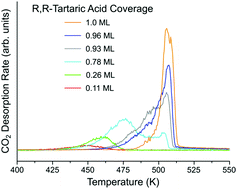Chiral nanoscale pores created during the surface explosion of tartaric acid on Cu(111)†
Abstract
The autocatalytic decomposition of tartaric acid on Cu(111) exhibits unique kinetics, which are linked to a hexagonal surface structure adopted at high coverage. The chirality imposed on the surface by tartaric acid throughout the explosion process is presented, and the hexagonal structure shows promise as a chiral template for enantiospecific surface chemistry.

- This article is part of the themed collection: Chirality at the nanoscale


 Please wait while we load your content...
Please wait while we load your content...